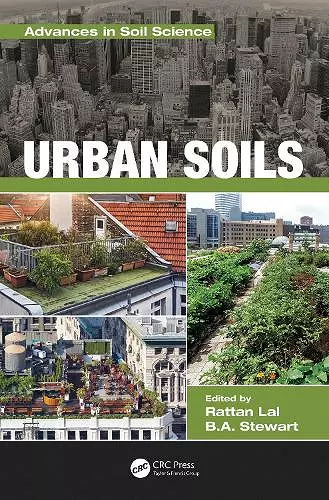Urban Soils
Rattan Lal editor B A Stewart editor
Format:Hardback
Publisher:Taylor & Francis Inc
Published:13th Oct '17
Currently unavailable, and unfortunately no date known when it will be back
This hardback is available in another edition too:
- Paperback£47.99(9781032096216)

Globally, 30% of the world population lived in urban areas in 1950, 54% in 2016 and 66% projected by 2050. The most urbanized regions include North America, Latin America, and Europe. Urban encroachment depletes soil carbon and the aboveground biomass carbon pools, enhancing the flux of carbon from soil and vegetation into the atmosphere. Thus, urbanization has exacerbated ecological and environmental problems.
Urban soils are composed of geological material that has been drastically disturbed by anthropogenic activities and compromised their role in the production of food, aesthetics of residential areas, and pollutant dynamics. Properties of urban soils are normally not favorable to plant growth—the soils are contaminated by heavy metals and are compacted and sealed. Therefore, the quality of urban soils must be restored to make use of this valuable resource for delivery of essential ecosystem services (e.g., food, water and air quality, carbon sequestration, temperature moderation, biodiversity).
Part of the Advances in Soil Sciences Series, Urban Soils explains properties of urban soils; assesses the effects of urbanization on the cycling of carbon, nitrogen, and water and the impacts of management of urban soils, soil restoration, urban agriculture, and food security; evaluates ecosystem services provisioned by urban soils, and describes synthetic and artificial soils.
'The book is an ideal starting material for graduate students who wish to obtain a grounding in soil science within an urban setting. Some chapters will also be useful for city planners who need to consider urban soils, ecosystem services, natural flood management, green infrastructure and food security when planning the expansion of our cities.'
-- Tom Sizmur, Royal Society of Chemistry
'Urban soils are composed of geological material that has been drastically disturbed by anthropogenic activities and compromised their role in the production of food, aesthetics of residential areas, and pollutant dynamics. Properties of urban soils are normally not favorable to plant growth¿the soils are contaminated by heavy metals and are compacted and sealed. Therefore, the quality of urban soils must be restored to make use of this valuable resource for delivery of essential ecosystem services (e.g., food, water and air quality, carbon sequestration, temperature moderation, biodiversity). Part of the Advances in Soil Sciences Series, "Urban Soils" explains properties of urban soils; assesses the effects of urbanization on the cycling of carbon, nitrogen, and water and the impacts of management of urban soils, soil restoration, urban agriculture, and food security; evaluates ecosystem services provisioned by urban soils, and describes synthetic and artificial soils. Knowledgeably compiled and co-edited by Rattan Lal, (Distinguished University Professor of Soil Science and Director of the Carbon Management and Sequestration Center, The Ohio State University) and B.A. Stewart (Director of the Dryland Agriculture Institute and a distinguished professor of soil science at West Texas A&M University, Canyon, Texas), "Urban Soils" is comprised of eighteen deftly organized and presented articles by experts in the field, making it unreservedly recommended for professional, corporate, governmental, and academic library Agricultural Science collections in general, and Soil Sciences supplemental studies reading lists in particular. It should be noted for students, academia, and non-specialist general readers with an interest in the subject that "Urban Soils" is also available in a digital book format (Kindle, $151.07).'
Source: Midwest Book Review November 2017
ISBN: 9781498770095
Dimensions: unknown
Weight: 934g
406 pages